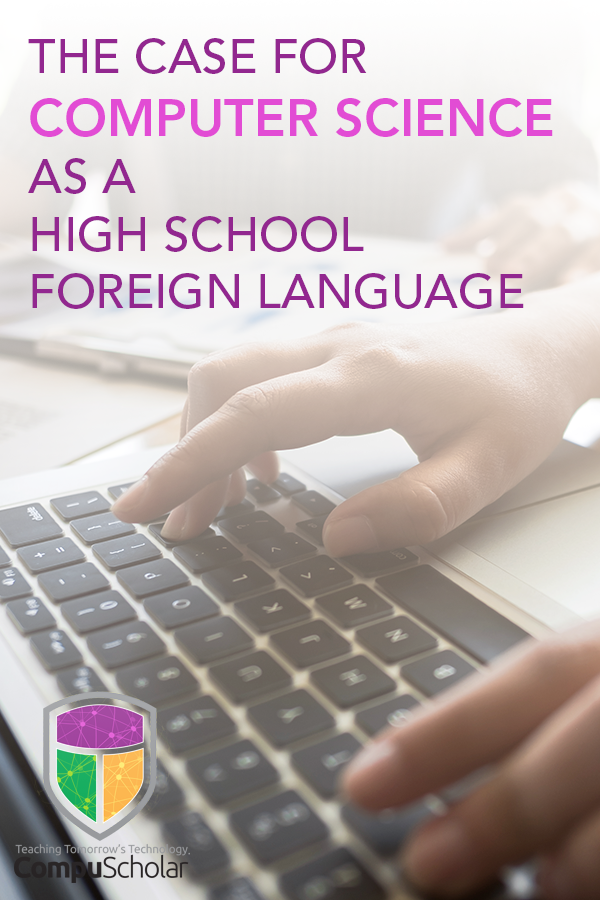 When technology advocates and educators suggest that computer science should be a high school graduation requirement, it‘s often met with trepidation. How will students fit it in with all the other requirements? How will the other programs be impacted? Above all, who is going to teach and create the courses? These questions are vital in presenting a plan and curriculum for every student from beginning coders to emerging engineers.
When technology advocates and educators suggest that computer science should be a high school graduation requirement, it‘s often met with trepidation. How will students fit it in with all the other requirements? How will the other programs be impacted? Above all, who is going to teach and create the courses? These questions are vital in presenting a plan and curriculum for every student from beginning coders to emerging engineers.
Most high schools require students take a minimum of two years of a foreign language. Many students choose languages such as Spanish, French, Latin, or Arabic. Although studying other languages is extremely valuable for secondary students, the language of computer science is, indeed, a foreign language. Learning Microsoft C# or studying Java in an introductory programming class requires acquisition of vocabulary just like a foreign language class. Even creating Android apps extends the language of Java for students continuing in that language of study. When elective course choices are limited, computer science could be an option as a foreign language requirement.
When it comes to the language of computers, it‘s important to note that just like traditional foreign languages, there are many options for course of study. While one student may choose to study Spanish while another focuses on Latin, a computer science student may choose to learn HTML, Python, Java, C#, or more! Just like traditional foreign languages, studying a computer language can help high school students get a heads up when entering college by taking AP exams as a culmination of their high school course study. Students may also choose to continue their study with collegiate level courses, regardless of their choice of degree.
Saving the Other Electives
Of course, I am certainly not advocating the elimination of foreign language study, rather just expanding the options for all students. Computer science skills are used in nearly all fields. Technology is expanding at a rate where many of today‘s high school students may enter into jobs that do not yet exist after post-secondary education. In fact, twelve years ago, there was no such thing as an iPhone. Who knows what the next twelve years will bring?
 For example, students could learn how to design a web site showcasing lessons learned in American History class. In Geometry class, an individual or team may create an app explaining different theorems and proofs. The possibilities are endless and can be spread throughout a term to make room for required curriculum while integrating state K-12 computer science framework standards.
For example, students could learn how to design a web site showcasing lessons learned in American History class. In Geometry class, an individual or team may create an app explaining different theorems and proofs. The possibilities are endless and can be spread throughout a term to make room for required curriculum while integrating state K-12 computer science framework standards.
Given that elective slots are limited for students during each high school grade, another option is integrating computer science study into all course studies. Using computer science lessons and courses to enhance current core classes with project-based and problem-based learning will help students develop skills necessary to bring them into the 21st century and beyond.
The Need for Computer Science Teachers
Computer science college graduates are typically not entering the K-12 education field. This is often because they can make more money working in the private sector. The good news is that you do not need a computer science degree to teach secondary education computer science courses. CompuScholar makes it easy with computer science and computer skills courses that are complete with lesson plans, videos, auto-graded quizzes and tests, syllabus, planner, and professional development. It‘s a win for the teacher and student!
Whether computer science is included as option for foreign language requirements or integrated into core curriculum, it‘s important for high school students to have access to computer skills and science study to make them marketable for collegiate admissions or future careers in any field. The language of technology bridges any field. Giving today‘s students more options to study computer science in school is easier than ever with ready-made courses available for teachers and high interest from 9-12 students.
About the Author
 Jen Schneider is an educator, learner, and writer in the Omaha, Nebraska area. Jen earned her B.A. in Journalism and Political Science and M.S. in Curriculum & Instruction. She is a middle school Language Arts teacher and PhD student at University of Nebraska-Lincoln studying innovative schools and instructional technology. Jen is passionate about teaching educators and students how to advance learning by using technology as a tool in the classroom. She believes in innovative instruction and learning goals driven by student learning, especially by using Genius Hour and project-based learning.
Jen Schneider is an educator, learner, and writer in the Omaha, Nebraska area. Jen earned her B.A. in Journalism and Political Science and M.S. in Curriculum & Instruction. She is a middle school Language Arts teacher and PhD student at University of Nebraska-Lincoln studying innovative schools and instructional technology. Jen is passionate about teaching educators and students how to advance learning by using technology as a tool in the classroom. She believes in innovative instruction and learning goals driven by student learning, especially by using Genius Hour and project-based learning.